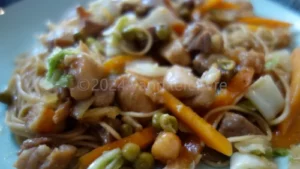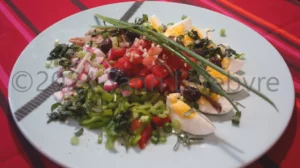Pissaladiere niçoise version 2024 with niçoise olives and anchovies from the Baie des Anges
Table of contents
Pissaladière is a speciality of Nice cuisine, made with bread dough, onions, anchovies, olive oil and small black olives from Nice.
In traditional Niçoise pissaladière, onions are mixed with « Pissalat » sauce (from the Niçois Occitan peis salat, « salted fish »), a paste made by macerating sardines and/or anchovies in coarse salt. Today, given the difficulty of obtaining real Pissalat, it’s replaced by anchovy fillets added to the pissaladière. That’s what I’d do for this 2024 version of pissaladière.
Dough mixing utensils
- A food processor with a dough hook
- A pastry horn
- A silicone work mat for rolling out the dough
- Pastry roller
Ingredients
Pissaladière dough
- 500 g flour (type 55) for 2 balls of bread dough
- 4 g salt
- 21 g fresh baker’s yeast
- 12 cl olive oil
- 22 cl warm water
The garnish

- 1 kg yellow onions
- 3 tablespoons olive oil, more if necessary…
- 2 tablespoons caster sugar
- A few Niçoise olives
- A few fillets of small anchovies preserved in brine and salt.
- Salt, pepper and herbes de Provence.
How to prepare the Pissaladière
The dough
- Crumble the yeast in a little warm water and a pinch of sugar to activate fermentation.
- Pour in warm water, fresh yeast and olive oil, then flour and salt. Knead in a food processor until the dough is homogeneous, smooth and elastic. As the dosage is perfect, we won’t get any soupy dough, and we won’t have to « baste » our dough.

- We can degas our dough for 2 minutes. This operation evacuates the gas generated during fermentation (acidity) to give a better flavor to the preparation and allows a better swelling during a second push and during cooking.
- You can repeat the pushing and degassing phases, and spread your dough on a silicone work mat.
- Cover the bowl with a damp cloth and leave the dough to rise for 1 hour at room temperature.
- Cut the ball in half, freeze one and keep the other cold.
The garnish
- I lift the fillets of small anchovies preserved in brine and salt.
- Cut onions into thin strips.
- Heat the olive oil in a large frying pan and add the onions, followed 15 minutes later by the sugar, salt, pepper and herbes de Provence.
- Leave to stew, stirring occasionally to prevent sticking, then caramelize over low heat for about 1h or 1h30.
- Roll out the pastry and place the onion compote on top.
- Place the black olives and anchovy fillets on the pissaladière.
Cooking
- Place in a preheated oven at 190°c (fan-assisted or fan-assisted) for 20 min.

Tips
- To use the food processor, I prefer to use at least 500 g of flour for better kneading. This quantity represents 2 balls of dough, which can be stored in the freezer.
- The proportion of liquid in pizza dough is generally between 60% and 70% water in relation to the total weight of flour: for our dough, I’ve done some tests and I’m going to go for 68% liquid, i.e. 34 cl of liquid for 500 g of type 55 flour (9% protein).
- The order in which ingredients are incorporated: always start with the liquids, which will give the flour a firm base and thus enable better kneading in the food processor.
- Use the dough hook for all leavened breads at medium speed 2
- Sticky dough: flour from sprouted wheat. Lack of strength = low protein % in flour (indicated on packet). As bakers explain, flours have an absorption capacity proportional to their strength. There’s a trick to reducing this lack-of-strength problem, which consists in pouring in 3/4 of the required amount of water at the start, and letting it form the bonds in the dough that will make it stronger and able to absorb the remaining water that will be added, little by little, after 1 minute of kneading. This technique is called « basining » the dough.
- Compact paste: add a tablespoon of water, or a little more if necessary.
- Use the horn to loosen the mixture and make kneading more even and efficient.
- Stretch a section of dough between your fingers. If the dough tears, knead more. If it stretches without tearing (forming a window), your dough is ready. Once you’ve established that your dough has been sufficiently kneaded, it’s time to let it rest.
Original ideas (Anthony ‘s corner)
- Adjust the amount of sugar, for example, or add garlic and herbs.
- Make a « homemade pissalat » to mix with the onion compote and brush over the dough before adding the onions to make the real niçoise pissaladière of our ancestors.
« Classic or modern, there’s only one kitchen…The right one. »
Paul Bocuse
French chef named « Chef of the Century » in 1989
On the channel there’s already the daube niçoise and I’d promised to continue the niçoise recipes, so on this page I’m proposing the pissaladière. As I explain at the top of the page, the traditional « Pissalat » is no longer up to standard and is no longer sold commercially. It has been replaced by a variety of anchovy pastes that I won’t be using. I won’t be making « homemade » Pissalat, which requires a month’s fermentation. I’ll show you how easy it is to make your own dough, as long as you have the right utensils, and how to make an excellent pissaladière without « Pissalat », but only with anchovy fillets and Niçoise olives.
Don’t hesitate to comment on my Youtube channel, should you find the recipe too difficult.
Follow my recipe for Pissaladière on Youtube





